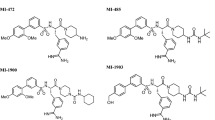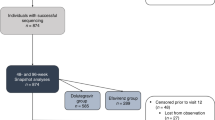Abstract
Aim:
20(S)-Ginsenoside Rh2 (Rh2) has shown potent inhibition on P-glycoprotein (P-gp), while most HIV protease inhibitors are both substrates and inhibitors of P-gp and CYP3A4. The aim of this study was to investigate the potential pharmacokinetic interactions between Rh2 and the HIV protease inhibitor ritonavir.
Methods:
The effects of Rh2 on the cellular accumulation and transepithelial transport of ritonavir were studied in Caco-2 and MDCK-MDR1 cells. Male rats were administered Rh2 (25 or 60 mg/kg, po) or Rh2 (5 mg/kg, iv), followed by ritonavir (25 mg/kg, po). The P-gp inhibitors verapamil (20 mg/kg, po) or GF120918 (5 mg/kg, po) were used as positive controls. The concentrations of ritonavir in plasma, bile, urine, feces and tissue homogenates were analyzed using LC-MS.
Results:
Rh2 (10 μmol/L) significantly increased the accumulation and inhibited the efflux of ritonavir in Caco-2 and MDCK-MDR1 cells, as verapamil did. But Rh2 did not significantly alter ritonavir accumulation or transport in MDCK-WT cells. Intravenous Rh2 significantly increased the plasma exposure of ritonavir while reducing its excretion in the bile, and oral verapamil or GF120918 also increased plasma exposure of ritonavir but without changing its excretion in the bile. Interestingly, oral Rh2 at both doses did not significantly change the plasma profile of ritonavir. Moreover, oral Rh2 (25 mg/kg) significantly elevated the ritonavir concentration in the hepatic portal vein, and markedly increased its urinary excretion and tissue distribution, which might counteract the elevated absorption of ritonavir.
Conclusion:
Rh2 inhibits the efflux of ritonavir through P-gp in vitro. The effects of Rh2 on ritonavir exposure in vivo depend on the administration route of Rh2: intravenous, but not oral, administration of Rh2 significantly increased the plasma exposure of ritonavir.
Similar content being viewed by others
Log in or create a free account to read this content
Gain free access to this article, as well as selected content from this journal and more on nature.com
or
References
Flexner C . HIV-protease inhibitors. N Engl J Med 1998; 338: 1281–92.
Carr A, Samaras K, Chisholm DJ, Cooper DA . Pathogenesis of HIV-1-protease inhibitor-associated peripheral lipodystrophy, hyperlipidaemia, and insulin resistance. Lancet 1998; 351: 1881–3.
Martinez E, Domingo P, Galindo MJ, Milinkovic A, Arroyo JA, Baldovi F, et al. Risk of metabolic abnormalities in patients infected with HIV receiving antiretroviral therapy that contains lopinavir-ritonavir. Clin Infect Dis 2004; 38: 1017–23.
Kitagawa I, Yoshikawa M, Yoshihara M, Hayashi T, Taniyama T . Chemical studies of crude drugs (1). Constituents of Ginseng radix rubra. Yakugaku Zasshi 1983; 103: 612–22.
Lai DM, Tu YK, Liu IM, Chen PF, Cheng JT . Mediation of beta-endorphin by ginsenoside Rh2 to lower plasma glucose in streptozotocin-induced diabetic rats. Planta Med 2006; 72: 9–13.
Wu N, Wu GC, Hu R, Li M, Feng H . Ginsenoside Rh2 inhibits glioma cell proliferation by targeting microRNA-128. Acta Pharmacol Sin 2011; 32: 345–53.
Fei XF, Wang BX, Tashiro S, Li TJ, Ma JS, Ikejima T . Apoptotic effects of ginsenoside Rh2 on human malignant melanoma A375-S2 cells. Acta Pharmacol Sin 2002; 23: 315–22.
Hwang JT, Kim SH, Lee MS, Yang HJ, Kim MJ, Kim HS, et al. Anti-obesity effects of ginsenoside Rh2 are associated with the activation of AMPK signaling pathway in 3T3-L1 adipocyte. Biochem Biophys Res Commun 2007; 364: 1002–8.
Lee CG, Gottesman MM, Cardarelli CO, Ramachandra M, Jeang KT, Ambudkar SV, et al. HIV-1 protease inhibitors are substrates for the MDR1 multidrug transporter. Biochemistry 1998; 37: 3594–601.
Drewe J, Gutmann H, Fricker G, Torok M, Beglinger C, Huwyler J . HIV protease inhibitor ritonavir: a more potent inhibitor of P-glycoprotein than the cyclosporine analog SDZ PSC 833. Biochem Pharmacol 1999; 57: 1147–52.
Kumar GN, Rodrigues AD, Buko AM, Denissen JF . Cytochrome P450-mediated metabolism of the HIV-1 protease inhibitor ritonavir (ABT-538) in human liver microsomes. J Pharmacol Exp Ther 1996; 277: 423–31.
Eagling VA, Back DJ, Barry MG . Differential inhibition of cytochrome P450 isoforms by the protease inhibitors, ritonavir, saquinavir and indinavir. Br J Clin Pharmacol 1997; 44: 190–4.
Zhang J, Zhou F, Wu X, Gu Y, Ai H, Zheng Y, et al. 20(S)-Ginsenoside Rh2 noncompetitively inhibits P-glycoprotein in vitro and in vivo: a case for herb-drug interactions. Drug Metab Dispos 2010; 38: 2179–87.
Zhang J, Zhou F, Wu X, Zhang X, Chen Y, Zha BS, et al. Cellular pharmacokinetic mechanisms of adriamycin resistance and its modulation by 20(S)-ginsenoside Rh2 in MCF-7/Adr cells. Br J Pharmacol 2012; 165: 120–34.
Yang Z, Gao S, Wang J, Yin T, Teng Y, Wu B, et al. Enhancement of oral bioavailability of 20(S)-ginsenoside Rh2 through improved understanding of its absorption and efflux mechanisms. Drug Metab Dispos 2011; 39: 1866–72.
Alsenz J, Steffen H, Alex R . Active apical secretory efflux of the HIV protease inhibitors saquinavir and ritonavir in Caco-2 cell monolayers. Pharm Res 1998; 15: 423–8.
Meaden ER, Hoggard PG, Newton P, Tjia JF, Aldam D, Cornforth D, et al. P-glycoprotein and MRP1 expression and reduced ritonavir and saquinavir accumulation in HIV-infected individuals. J Antimicrob Chemother 2002; 50: 583–8.
Lee LS, Wise SD, Chan C, Parsons TL, Flexner C, Lietman PS . Possible differential induction of phase 2 enzyme and antioxidant pathways by American ginseng, Panax quinquefolius. J Clin Pharmacol 2008; 48: 599–609.
Andrade AS, Hendrix C, Parsons TL, Caballero B, Yuan CS, Flexner CW, et al. Pharmacokinetic and metabolic effects of American ginseng (Panax quinquefolius) in healthy volunteers receiving the HIV protease inhibitor indinavir. BMC Complement Altern Med 2008; 8: 50.
Denissen JF, Grabowski BA, Johnson MK, Buko AM, Kempf DJ, Thomas SB, et al. Metabolism and disposition of the HIV-1 protease inhibitor ritonavir (ABT-538) in rats, dogs, and humans. Drug Metab Dispos 1997; 25: 489–501.
Molimard M, Diquet B, Benedetti MS . Comparison of pharmacokinetics and metabolism of desloratadine, fexofenadine, levocetirizine and mizolastine in humans. Fundam Clin Pharmacol 2004; 18: 399–411.
Lam JL, Benet LZ . Hepatic microsome studies are insufficient to characterize in vivo hepatic metabolic clearance and metabolic drug-drug interactions: studies of digoxin metabolism in primary rat hepatocytes versus microsomes. Drug Metab Dispos 2004; 32: 1311–6.
Acknowledgements
This study was supported by the National Basic Research Program of China 973 Program 2011CB505303, the National Natural Science Foundation of China (81072692), the Project Program of State Key Laboratory of Natural Medicines, China Pharmaceutical University (JKGP201108-AJY), and the Project for Jiangsu Province Key Lab of Drug Metabolism and Pharmacokinetics (BM2012012).
We sincerely thank Associate Professor Fang ZHOU and Dr Jing-wei ZHANG (Key Lab of Drug Metabolism and Pharmacokinetics, China Pharmaceutical University, Nanjing, China) for their assistance and advice on this article.
Author information
Authors and Affiliations
Corresponding author
Additional information
Supplementary information is available at Acta Pharmacologica Sinica website.
Supplementary information
Supplementary information Figure 1
Inhibition of ritonavir metabolism by ketoconazole, troleandomycin or 20(S)-ginsenoside Rh2 (Rh2) in rat liver microsomes. (DOC 80 kb)
Rights and permissions
About this article
Cite this article
Shi, J., Cao, B., Zha, Wb. et al. Pharmacokinetic interactions between 20(S)-ginsenoside Rh2 and the HIV protease inhibitor ritonavir in vitro and in vivo. Acta Pharmacol Sin 34, 1349–1358 (2013). https://doi.org/10.1038/aps.2013.69
Received:
Accepted:
Published:
Issue date:
DOI: https://doi.org/10.1038/aps.2013.69
Keywords
This article is cited by
-
Pharmacokinetics and pharmacodynamics of Rh2 and aPPD ginsenosides in prostate cancer: a drug interaction perspective
Cancer Chemotherapy and Pharmacology (2023)
-
Inhibition of drug-metabolizing enzymes by Jingyin granules: implications of herb–drug interactions in antiviral therapy
Acta Pharmacologica Sinica (2022)
-
Therapeutic Potential and Utility of Elacridar with Respect to P-glycoprotein Inhibition: An Insight from the Published In Vitro, Preclinical and Clinical Studies
European Journal of Drug Metabolism and Pharmacokinetics (2017)
-
Membrane Assays to Characterize Interaction of Drugs with ABCB1
The Journal of Membrane Biology (2015)



